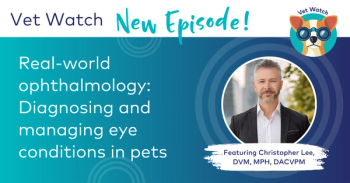
How to approach the squinty cat (Proceedings)
There are many potential pathogens that can lead to ocular irritation in cats; of note are Chlamydophila felis, Calicivirus, Mycoplasma, and Feline herpesvirus 1.
There are many potential pathogens that can lead to ocular irritation in cats; of note are Chlamydophila felis, Calicivirus, Mycoplasma, and Feline herpesvirus 1 (FHV1). Of these pathogens, FHV1 is by far the most incriminated when it comes to chronic and recrudescent conjunctivitis, blepharitis, and keratitis.
Chlamydophila felis
The most common ocular sign associated with Chlamydophila felis is chemosis. There are 2 morphologic forms of C. felis: the elementary body, which is an extracellular infectious form, insensitive to antibiotics, and the reticulate body, which is the intracellular form that leads to cellular damage. The reticulate form is sensitive to antibiotics. Transmission of C. felis is generally thought to be via aerosolization, direct contact, or contracted via fomites. Incubation is 3-5 days, and C. felis is shed for approximately 60 days after inoculation. Clinical signs include chemosis, hyperemia, serous discharge and blepharospasm. Cats less than 1 year are most likely to become infected; cats greater than 5 are fairly resistant. Chalmydophila infections tend to follow a chronic course, that typically begins with unilateral clinical signs that then can include the contralateral eye. The clinical signs typically resolve in a few weeks, although mild conjunctivitis can persist for months.
In a study (Vet Record, 1994) comparing 6 otherwise healthy to 6 FIV positive cats experimentally infected with C. Felis, clinical signs in control cats resolved within a mean of 109 days post-infection, while in FIV infected cats clinical sings persisted beyond 200 days.
Cytology of the intracytoplasmic reticulate bodies days 3-14 post-inoculation has poor sensitivity and specificity; false positives are common. PCR and serology after day 32 of inoculation are possible diagnostic tools. However, cell culture is considered the gold standard for the identification of C. felis. Cats vaccinated prior to conjunctival and nasal infections developed milder ocular and URI signs than unvaccinated cats, with a shorter shedding period. However, the vaccine doesn't prevent infection or clinical signs, and can be associated with fever, lethargy, anorexia and lameness following vaccination.
Therapeutic options for the treatment of C. felis include doxycycline, azithromycin and clavamoc. Doxycycline appears to be the most efficacious for C. felis with clinical improvement in as few as 2 days.
Calicivirus
Calicivirus is a single stranded non-enveloped RNA virus, transmitted via aerosols or fomites. The virus typically incubates for 2-3 days, and results in acute respitatry tract signs, including glossal ulceration. It also results in polyarthritis and conjunctivitis in cats. It is generally considered a self-limiting disease process, which appears to resolve in 7-10 days. Topical antivirals do not appear to be effective as all of our topical antivirals target DNA, not RNA. Calicivirus also does not result in latent infections.
Calicivirus is diagnosed via cell culture, scrapings of respiratory of conjucntival secretions, immunohistochemical stainin, and electron biomicroscopy. Prevention is via the modified live or killed vaccine.
Mycoplasma
Mycoplasma felis and M. gatae are two isolates that are also incriminated in ocular irritation. Mycoplasma spp. Have questionable clinical significance because they have been isolated from clinically normal cats and have resulted in viariable conjunctivitis when administered experimentally. In addition, the disease process has not been replicated when cats were experimentally infected.
Diagnosis is via culure, cytology (noting the epithelial cytoplasmic basophilic inclusion bodies), and PCR (which has the highest sensitivity and specificity). Topical antibiotics have resulted in resoliution of ocular clinical signs.
Feline herpesvirus 1 (FHV1)
Feline herpesvirus 1 is an enveloped alphaherpesvirus known for its notorious chronic tissue latency. It is environmentally very fragile, and only lives 12-18 hours outside of a host. It is transmitted via direct contact or aerosolization, and infects the oral, nasal, and conjucntival surfaces. Like all herpesviruses, FHV1 is highly species specific. Its seroprevalence within the feline population has been reported as high as 97%.
Feline herpesvirus 1 infects the epithelial cells lining the respiratory tract, conjunctiva and corneal epithelium. The replicating virus results in cytolysis and causes inflammatory-mediated cell damage 4-6 days following exposure. Of note, it also established latency in the trigeminal ganglia, and can chronically and repeatedly travel to the eye via anterograde axonal transport, spontaneously shedding virus particles.
Maternal antibody protection wanes 8-12 weeks following birth. Although the course of the disease process can be self-limiting (10-20 days), it can result in severe ocular signs, including hyperemia, blepharospasm, chemosis, serous to purulent ocular discharge, corneal ulceration and keratitis, and fibrinocellular exudate. Dendritic corneal ulcers are pathognominic for this disease process. It is often associated with a concurrent upper respiratory tract infection.
Cytology is often unrewarding, as it is likely only useful in primary infections and inclusion bodies are rare. Histopathology reveals epithelial necrosis 4 days following infection with a neutrophilic infiltrate, fibrosis and scarring. Viral detection is best performed via PCR using a dry cotton swab and performing a standard volume PCR assay. Virus isolation, fluorescent antibody, serum neutralizing antibody and ELISA testing have also been documented to detect FHV1. Prevention is difficult due to the high seroprevalence of FHV1, although vaccination may help protect against future disease episodes.
The contraindication of corticosteroids and FHV1 has been documented in the literature. Steroids have been associated with persistent and progressive corneal ulceration, neovascularization, prolonged viral shedding, corneal sequesta formation, calcific band keratopathy, and decreased tear production. Also, secondary bacterial infections may complicate viral flare-ups, and warrant the use of concurrent antibiotic therapy.
Topical and systemic antiviral therapy is often warranted. Potential antiviral therapeutic options include trifluridine, idoxuridine, vidarabine, cidofovir, acyclovir and famciclovir. Other therapies include the utilization of interferon, lysine and mucinomimetics.
Feline herpesvirus 1 may be associated with other disease processes, including eosinophilic conjunctivitis and keratitis, corneal sequestrum formation and dendritic dermatitis.
References
Veterinary Ophthalmology (ed Gelatt, KN) 5th Edition;, Vol2 Ames: Wiley-Blackwell
Newsletter
From exam room tips to practice management insights, get trusted veterinary news delivered straight to your inbox—subscribe to dvm360.






